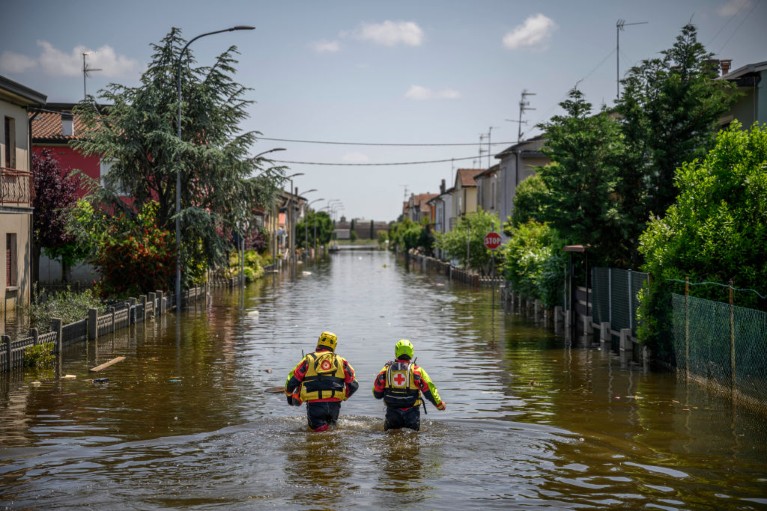Operators of the Italian Red Cross and firefighters seek residents blocked in their homes on May 25, 2023 in Conselice, Italy, after heavy rains caused flooding across Italy's Emilia Romagna region. Credit: Antonio Masiello/ Stringer/ Getty Images News.
After severe floods hit the Emilia-Romagna region in May, killing 17 people and displacing 37,000 more, questions emerged about the causative factors. Were the heavy rainfalls that caused the floods exceptional events, or were preventive measures just insufficient? Did global warming contribute more or less than bad soil management?
The floods followed three consecutive deluges, and the second one, on 16 May, was the most intense. “Preliminary analyses indicate that the rainfall over 36 hours reached an extreme value”, says Alberto Montanari, a hydrologist at the University of Bologna. “But the maximum hourly value could not be considered extreme.”
Scientists are not yet able to assess the role of climate change in this specific flooding event.A preliminary attribution study for the Italian flood was published on 31 May by the World Weather Attribution group of scientists, and has not yet been peer-reviewed. Attribution studies compare the probability of a specific event occurring in the current climate with the probability that the same event would have without anthropogenic greenhouses gas emissions, relying on both climate models and historical observations.
Historical records on short but intense rainfalls, which can cause small river basins like those in Emilia-Romagna to flood, are not long enough to detect any trend. The World Weather Attribution authors found that the variable that better represents the nature of this event is the cumulative precipitation over 21 days at the beginning of May in Emilia-Romagna. They looked at data collected by regional rain gauges since the 1960s and found that the volume recorded in the first three weeks of May this year was in fact extreme, with a return period of about 200 years. The authors found that extreme events of this kind are not becoming more frequent or more intense. They write that “the amount of rain that falls in a 200-year event today is the same as in a 200-year event at the beginning of the record”. Simulation conducted with climate models also corroborate this preliminary finding. “Of the 19 models used, none of them show a significant change in the likelihood or intensity of such an event”, the authors write.
Montanari says that climate models have limited reliability in simulating extreme rainfalls, especially at the local scale. The three events occurred in Emilia-Romagna are particularly difficult to simulate, because they are caused by convection, a process where moist air lifts towards the higher atmosphere and rapidly cools off. Simulating convection requires small-scale models of the Earth system that are computationally unaffordable for most research centres.
This does not mean that the impact of global warming on rainfall is not known. Basic physical laws predict that as global mean temperature rises, rainfall should also rise at the global scale. It may increase in some regions and decrease in some others, but most climate models agree that extreme rainfall will become more intense and more frequent in all regions except subtropical areas, such as the southern part of the Mediterranean. This has also been confirmed by historical data.
As for river floods, in 2019, in a study published in Nature scientists looked at historical observations in Europe to search for any trend due to global warming. As with the case for rainfall, the results were mixed: in some regions river floods increased while in other decreased. But that study considered only large and medium river basins, for which historical time series are longer and more complete. They could not assess the impact of global warming on small river basins, “because they are usually not monitored or the flood series are too short for trend analyses,” wrote the authors of the 2019 study.
Urbanization of the region has also been deemed responsible for the floods. Montanari believes that “given the exceptional nature of the rainfall events, land-use change didn’t play a central role”. When an extreme event occurs, he says, soils saturate quickly and the capacity to absorb rainfalls reduced for both pavement and vegetation.
Armando Brath, a civil engineer at the University of Bologna who leads the hydrogeological risk section of the Civil Protection’s scientific advisory body, has a different opinion. “The rainfall was intense, but the effects on the territory were exacerbated by the land-use change over the last 50 years,” he says. Changes in farming practices have been particularly relevant, he says, especially the mechanical tillage of agriculture land and the disappearance of small-scale drainage networks. Brath also notes that riverbeds have been artificially narrowed, as in many other parts of Italy.
Regardless of what caused the disaster, experts point out that reducing the vulnerability of territories and improving emergency management are priorities. Barbara Lastoria from Istituto Superiore per la Protezione e la Ricerca Ambientale (ISPRA) says that the European Floods directive, effected by Italian law, required to introduce in the flood risk management plans measures to improve the emergency response, such as warning systems and controlled floodings. Both were used in Emilia-Romagna.
The Civil Protection department oversees communicating early warnings to the public in collaboration with the national weather service. “The second rainfall event was forecast 48 hours in advance and this made a big difference,” says Montanari.
